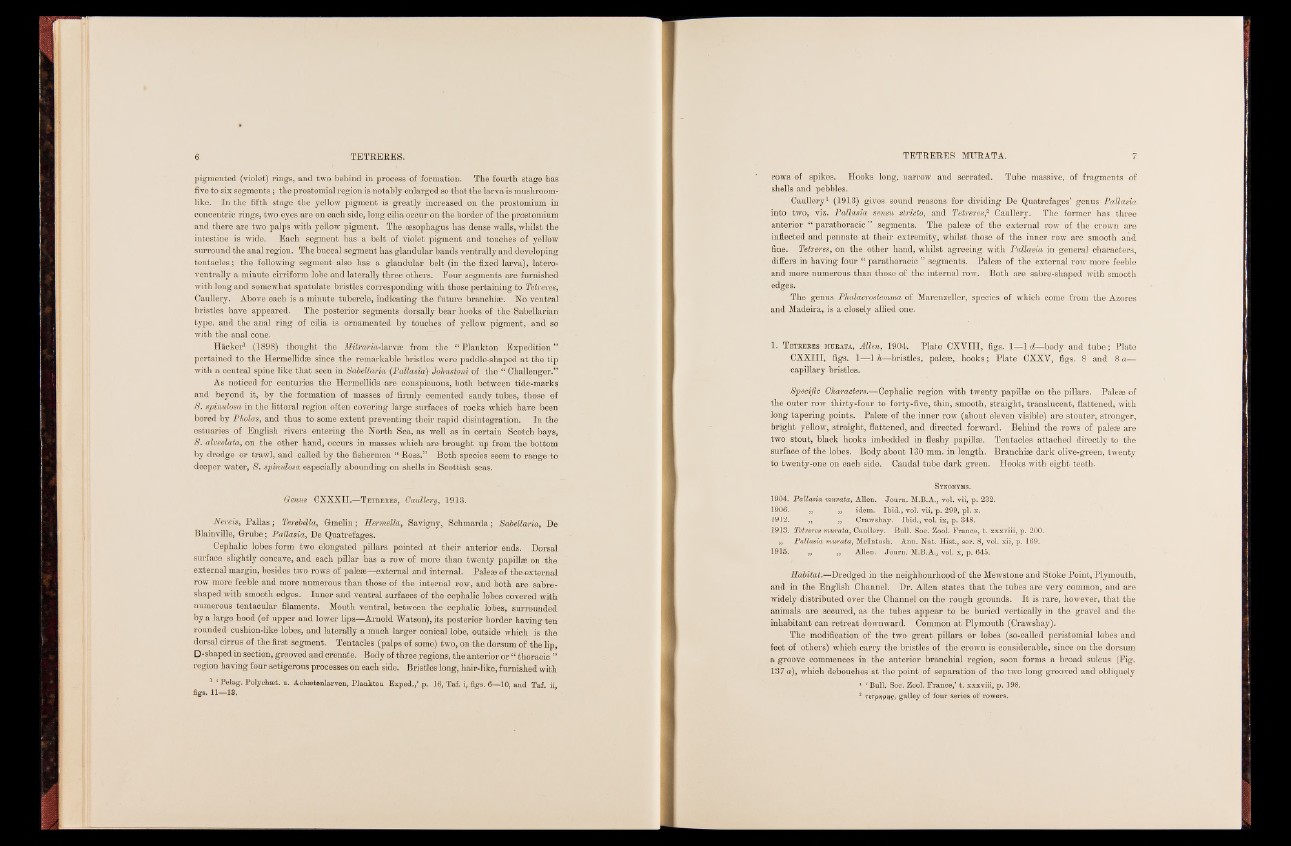
pigmented (violet) rings, and two behind in process of formation. The fourth stage has
five to six segments; the prostomial region is notably enlarged so that the larva is mushroomlike.
In the fifth stage the yellow pigment is greatly increased on the prostomium in
concentric rings, two eyes are on each side, long cilia occur on the border of the prostomium
and there are two palps with yellow pigment. The oesophagus has dense walls, whilst the
intestine is wide. Each segment has a belt of violet pigment and touches of yellow
surround the anal region. The buccal segment has glandular bands ventrally and developing
tentacles ; the following segment also has a glandular belt (in the fixed larva), latero-
ventrally a minute cirriform lobe and laterally three others. Four segments are furnished
with long and somewhat spatulate bristles corresponding with those pertaining to Tetreres,
Caullery. Above each is a minute tubercle, indicating the future branchiae. Ho ventral
bristles have appeared. The posterior segments dorsally bear hooks of the Sabellarian
type, and the anal ring of cilia is ornamented by touches of yellow pigment,-^ and so
with the anal cone.
Häcker1 (1898) thought the Mitraria-larvze from the “ Plankton Expedition ”
pertained to the Hermellidge since the remarkable bristles were paddle-shaped at the tip
with a central spine like that seen in Sabellaria (Pallasia) Johnstoni of the “ Challenger.”
As noticed for centuries the Hermellids are conspicuous, both between tide-marks
and beyond it, by the formation of masses of firmly cemented sandy tubes, those of
8. spinulosa in the littoral region often covering large surfaces of rocks which have been
bored by Pkolas, and thus to some extent preventing their rapid disintegration. In the
estuaries of English rivers entering the North Sea, as well as in certain Scotch bays,
8. alveolata, on the other hand, occurs in masses which are brought up from the bottom
by dredge or trawl, and called by the fishermen “-Ross.” Both species-seem to range to
deeper water, 8. spinulosa especially abounding on shells in Scottish seas.
Genus CXXXII.—Tetreres, Caullery, 1913.
Nereis, Pallas; Terebella, Gmelin; Hermella, Savigny, Schmarda; Sabellaria, De
Blainville, Grube; Pallasia, De Quatrefages.
Cephalic lobes form two elongated pillars pointed at their anterior ends. Dorsal
surface slightly concave, and each pillar has a row of more than twenty papillse on the
external margin, besides two rows of pales©—external and internal. Palese of the external
row more feeble and more numerous than those of the internal row, and both are sabreshaped
with smooth edges. Inner and ventral surfaces of the cephalic lobes covered with
numerous tentacular filaments. Mouth ventral, between the cephalic lobes, surrounded
by a large hood (of upper and lower lips—Arnold Watson), its posterior border having ten
rounded cushion-like lobes, and laterally a much larger conical lobe, outside which is the
dorsal cirrus of the first segment. Tentacles (palps of some) two, on the dorsum of the lip,
D-shaped in section, grooved and crenate. Body of three „regions, the anterior or “ thoracic ”
region having four setigerous processes on each side. Bristles long, hair-like, furnished with
1 ‘ Pelag. Polychaet. u. Achmtenlarven, Plankton Exped./ p. 16, Taf. i, figs. 6—10, and Taf ii figs. 11—13. ’ '
rows of spikes. Hooks long, narrow and serrated. Tube massive, of fragments of
shells and pebbles.
Caullery1 (1913) gives sound reasons for dividing De Quatrefages’ genus Pallasia
into two, viz. Pallasia sensu stricto, and Tetreres,a Caullery. The former has three
anterior “ parathoracic ” segments. The paleas of the external row of the crown are
inflected and pennate at their extremity, whilst those of the inner row are smooth and
fine. Tetreres, on the other hand, whilst agreeing with Pallasia in general characters,
differs in having four “ parathoracic ” segments. Palese of the external row more feeble
and more numerous than those of the internal row. Both are sabre-shaped with smooth
edges.
The genus Phalacrostemma of Marenzeller, species of which come from the Azores
and Madeira, is a closely allied one.
1. Tetreres murata, Allen, 1904. Plate CXVIII, figs. 1—Id—body and tube; Plate
CXXIII, figs. 1—1 h—bristles, palese, hooks; Plate CXXV, figs. 8 and 8 a—
capillary bristles.
Specific Character's.—Cephalic region with twenty papillae on the pillars. Palese of
the outer row thirty-four to forty-five, thin, smooth, straight, translucent, flattened, with
long tapering points. Palese of the inner row (about eleven visible) are stouter, stronger,
bright yellow, straight, flattened, and directed forward. Behind the rows of palese are
two stout, black hooks imbedded in fleshy papillse. Tentacles attached directly to the
surface of the lobes. Body about 130 mm. in length. Branchise dark olive-green, twenty
to twenty-one on each side. Caudal tube dark green. Hooks with eight teeth.
Synonyms.
1904. Pallasia mu/rata, Allen. Journ. M.B.A., vol. vii, p. 232.
1906. ■ „ „ idem. Ibid., vol. vii, p. 299, pi. x.
1912. „ : Crawshay. Ibid., vol. ix, p. 348.
1913. Tetreres murata, Caullery. Bull. Soc. Zool. France, t. xxxviii,.p. 200.
,, Pallasia murata, McIntosh. Ann. Nat. Hist., ser. 8, vol. xii, p. 169.
1915. „ „ '. Allen. Journ. M.B.A., vol. x, p. 645.
Habitat.—Dredged in the neighbourhood of the Mewstone and Stoke Point, Plymouth,
and in the English Channel. Dr. Allen states that the tubes are very common, and are
widely distributed over the Channel on the rough grounds. It is rare, however, that the
animals are secured, as the tubes appear to be buried vertically in the gravel and the
inhabitant can retreat downward. Common at Plymouth (Crawshay).
The modification of the two great pillars or lobes (so-called peristomial lobes and
feet of others) which carry the bristles of the crown is considerable, since on the dorsum
a groove commences in the anterior branchial region, soon forms a broad sulcus (Fig.
137 a), which debouches at the point of separation of the two long grooved and obliquely
1 ‘ Bull. Sbc. Zool. France,’ t. xxxviii, p. 198.
3 Ttrpi\priQ, galley of four series of rowers.